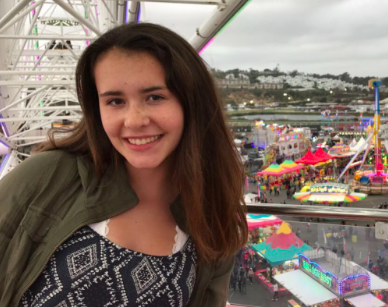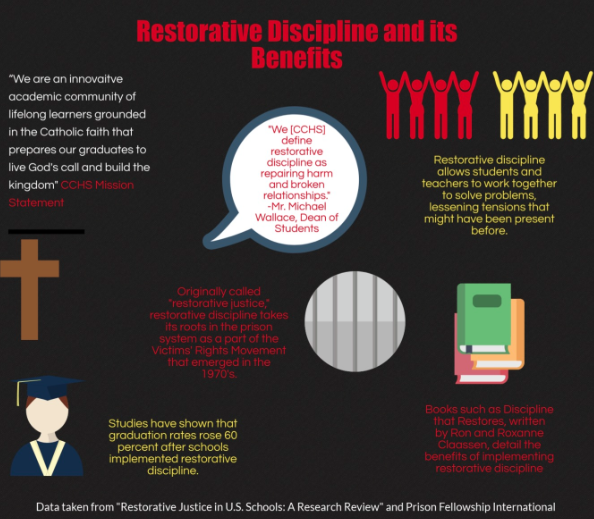Restoring relationships
Cathedral Catholic High School student Nikki Mullin ’19 knows all to well what it is like to receive one of the more than 2,000 of detentions issued to CCHS students during the 2016-2017 school year.
“I have been issued a number of skirt detentions throughout my time at CCHS,” Mullin said. “I feel that they are really counter-productive in trying to make me wear my skirt longer.”
In past years, CCHS students faced a 45-minute, after-school detention for a first and second offense for a uniform infraction, which gradually progresses if infractions continue.
However, the punishment process will look a little different in upcoming school years. Instead of just giving students detentions for violating school rules, the discipline process will become more personal and conversational. Under the new plan, students will meet with aggrieved teachers, deans, or even students to discuss why they broke a school rule and how they can remedy the problem.
This change in punishment is part of the new restorative discipline program being implemented by CCHS Principal Dr. Kevin Calkins, Dean of Students Mr. Michael Wallace, Asst. Dean of Students Mr. Manuel Terzoli, and Director of Cathedral Cares medical home school program Dr. Kathy McIntosh CCHS for the 2018-19 school year. Dr. McIntosh has worked at the collegiate level with restorative discipline at the University of San Diego and California State University San Marcos.
“There is no exact definition of what restorative discipline should be since every school is different, but [CCHS] define it as repairing harm and broken relationships,” Mr. Wallace said. “These relationships can be student-student, student-teacher, etc.”
Implementing restorative discipline at CCHS has been in the works for two years. Dr. Calkins, Mr. Wallace, Mr. Terzoli, and Dr. McIntosh meet once a week to discuss the program and to keep moving it forward. Nobody has a specific job yet regarding his/her role in implementing restorative discipline, Dr. McIntosh said.
Full implementation of restorative discipline will begin in 2019, with the 2018 school year being more of a test run, allowing for teachers to train and to get a better feel for what restorative discipline means, Mr. Wallace said. The only funding required for the program would be in making sure that teachers are thoroughly trained in restorative discipline practice.
Next year, classrooms will include respect agreements, and although detentions are not fully out of the question next year, they will become more meaningful, according to Mr. Wallace.
CCHS teachers have attended two informational meetings, one in November and one in January, so far to learn more about restorative discipline. One meeting featured Immanuel High School Superintendent Ryan Wood, who implemented a restorative program at his school 12 years ago.
Dr. Calkins and Mr. Wallace visited Immanuel in September 2017 to observe the practice in action.
Being principal when restorative discipline was first implemented at IHS, Mr. Wood was responsible for all of the training involved with its implementation, and now as the superintendent, his role is more daily.
“We felt it was necessary to implement restorative discipline because we were not seeing change in behavior using the old punitive system,” Mr. Wood said. “We also felt it aligned with our Christian values better as a school. We want our students to grow, and we felt that punitive discipline was not achieving that.”
Since its implementation, tensions between teachers and students have lessened, and now they work together to resolve conflicts and problems. Restorative discipline has been cemented into Immanuel’s school culture, according to Mr. Wood.
Dr. Calkins and Mr. Wallace also visited Le Grande High School, a school with a violent history involving gang violence and a high suspension rate. In order to combat this, the school has instituted a student leadership class known as the Justice League, as well as a place called the Thinkery, where students and teachers consult with a professional conflict resolution counselor to resolve conflicts.
Since restorative discipline looks different at every institution, CCHS will not be implementing programs such as the Justice League and the Thinkery.
“We have considered both, but in the upcoming years, we are looking to possibly implement a student leadership class that is designed to help resolve person to person conflicts,” Mr. Wallace said. “Restorative discipline will grow once we learn what helps students.”
Additionally, another challenge with restorative discipline is that there is no set guidelines for a specific response concerning each infraction. At the meeting between the two parties involved in an incident, the conversation would be more toward solving the problem, rather than just punishing the student.
According to Mr. Wallace, if the problem does not cease, a possibility would be creating a contract to which the student must agree. If the same infraction still keeps occuring, the problem is now respect for CCHS as an institution, not just a violation of conduct. The student would have to consider if CCHS is the right place for them.
“High school is a time where students should be creating lifelong skills,” Mr. Wallace said. “You don’t get detentions in the workplace if you do something wrong, but you do have a conversation about it and try to come up with a resolution. [CCHS] needs to teach students about taking accountability for their actions and how they can solve their problems.”
Restorative discipline also goes hand in hand with the CCHS new drug and alcohol awareness program, given that CCHS is now not zero tolerance. The goal, like with the drug and alcohol awareness program, is to have a conversation with the student and to solve the problem presented.
Similar to IHS, catholicism will play a part in implementing this program, since faith is at the foundation of CCHS and its mission.
“Since we are a faith-based school, faith can definitely be a part of the conversation,” Dr. McIntosh said. “If you look at our mission statement and what we hope to achieve for each student, faith is at the center, as well as restorative.”
While it may take a few years for CCHS to fine tune its restorative approach, CCHS administrators know it ultimately comes down to what helps the students and what fits the CCHS culture.
“I really like restorative discipline because it gives the student more of a voice in the conversation,” Dr. McIntosh said. “It is not [CCHS] punishing you. It’s more of a sit down and talk. If there are possibly bigger issues that you are struggling with, [CCHS] wants to help you with it.”

After an exciting year as the Photo and News Editor for El Cid, I will lead the new Entertainment section as the editor. I look forward to learning even...





















































